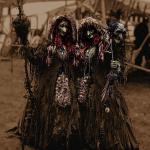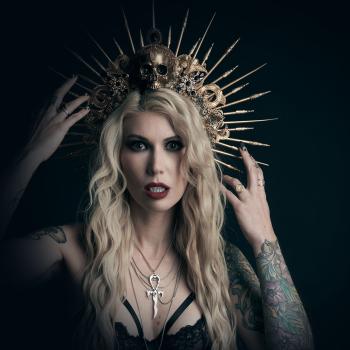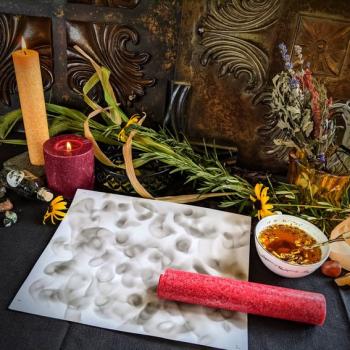It seems as though different deities and spirits reach out to me at different times throughout the year. Deities that I have approached and explored in the past speak louder at certain times demanding my attention. Through an exploration of their myths and mysteries I am able to unearth the messages they are trying to deliver. In this case it was the goddess Hel/Hela. During this Hallows tide deities like Hecate, Persephone, Demeter and others are honored. However, Hel, the Norse goddess of death will not be forgotten. She is an embodiment of this twilight time of year.
 Image from pixabay.com Creative Commons
Image from pixabay.com Creative Commons
Hela Goddess of the Dead and the Netherworld
This is the time of year that we pay special homage to the dark side of nature, the shadow and the hidden things beneath the earth. Powers that some of us immerse ourselves in all year round. The allure these powers hold is inescapable for those that walk the darker paths honoring the spirits that hide in the shadows. We seek to commune with the dead and learn of their mysteries. Deities of the Night, Death, and the Underworld receive our offerings. It is the Goddess Hel that rules the realm of the dead in the Northern Traditions, presiding over the spirits that dwell there. It is with her blessing that one may pass through the veil to retrieve the knowledge kept there.
Hel or Hela is the Norse goddess of the Dead and the Queen of the Netherworld known as Helheim. She is the daughter of Loki and Angrboda the giantess, and is a member of the Rökkr, a group of dark deities in the Norse pantheon. This categorization is akin the tribes of the Aesir and Vanir in Norse mythology. They are the dark and primal spirits associated with the wild and elemental forces of Nature.
Rulership of Helheim, the Norse Underworld, was coveted by the tribes of the gods who desired to ally themselves with the undefeatable power of death. They saw the advantage they would gain by having one of their kin ruling the realm of the dead. The gods awaited the predestined appointment of Helheim’s next ruler, which came with the arrival of the daughter of Loki and Angrboda. Hel, a beautiful maiden, who was both dark and light, living and dead was fated to be the Queen of Helheim. She is depicted as a beautiful woman on one side and a rotting corpse on the other, showing the dual nature of life and death, forcing us to confront their interconnectedness.
 Image from pixabay.com Creative Commons
Image from pixabay.com Creative Commons
Hela’s Realm
Taking her new position, Hela was banished from Asgard out of fear of her new authority. She was sent to rule over the dead, specifically those not slain in battle. She welcomes all the dead to her halls. She takes those who die the “straw death” of old age, disease, and mothers and children who die during childbirth. She does not discriminate and welcomes all who died off of the battlefield. Her realm is known as the Land of Mist, and is connected to the icy realm of Niflheim. Nifl an aspect of Hel rules this realm of frost and ice, which is sometimes seen as part of Hel’s realm. Helheim is said to lie beneath one of the three roots of the World Tree, which is also close to the dwelling place of the Norns. Her name, Hel, means to conceal, cover, or hidden. Hidden by the Veil, this goddess is connected to the boundary between the living and the dead. She can be called upon for divination, and safe passage for those who desire to travel through her realm. Hela is a “hedge sitter”, Hagazussa, a goddess that exists between life and death. Her intermediary nature is important to those who work closely with the spirit realm. She is called upon for rites of scrying, oneiromancy, and any means of communication with the dead.
Helheim is a realm of perpetual autumn. It was fashioned by the goddess when she took her throne. She created a peaceful place for the dead from the dark, dank caves of what was once Jormungund. There is a bridge that leads into her realm, Helvegen, or Hel’s Road that is guarded by the goddess Mordgud. This powerful female warrior tests those who would enter Hela’s realm, allowing only those who have Hela’s blessing to enter. The goddess can be petitioned prior to attempting to enter her realm, or before divination rituals to aid the seer or shaman with their work. Only the dead who choose to speak are able to be reached, and are met in special in between places in Helheim. There are other deeper areas of her realm that cannot be accessed by the living.
 Public domain
Public domain
Altars to the Goddess of the Dead
Offerings can be made to Hela in various ways that correspond to her nature, those places in the middle realm that are closest to the Underworld. Natural caves and tunnels, wells and crossroads, which have long been associated with the Netherworld and spirit roads that the dead travel are all appropriate places for seeking out Hela. Places of isolation in the wild, specifically the trunks of decaying and broken trees make perfect natural altars for the goddess of death and decomposition. Abandoned cemeteries, stone ruins and old bridges are also appropriate places for making offerings to this goddess. Tending to these forgotten places, and paying them homage are honorable ways for reaching out to her.
Her altars are dressed with dark fabrics, rich deep colors of crimson and rust, even the fallen leaves abundant this time of year add to the sensory experience of putreficatio. Skulls, bones and the pelts of nocturnal animals may also be used. Offerings of food, specifically dark breads, meats, beer and wine, are also fine offerings for her. There are a number of botanical associations that connect with this goddess and her realm. In particular, Apples, the fruit of the Underworld, are used during Samhain celebrations and any altar dedicated to the dead. Hela is also connected to Atropa belladonna, Deadly Nightshade whose dark flowers and black berries are used not only for offerings but also in formulas especially potent in connecting with the dead. This baneful herb, associated with the darker side of magic and witchcraft is also connected with the Norns. These goddesses that weave and cut the thread of life are inevitably associated with death and her mysteries. Trees of the dead and Underworld, such as Yew and Elder are also appropriate in ritual tools and altar adornments for working with these goddesses. The area occupied by these trees are also traditional places of traveling to her realm. Dried flowers and herbs such as wormwood can also be used in rituals related to the dead. After tending to forgotten graves, with permission if possible, the desiccated flowers of expired funeral arrangements can also serve as offerings to Hela to gain entry to her realm.
Further resources:
Rokkr: Twilight, Shadow Darkness












